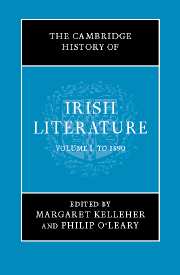Book contents
- Frontmatter
- Introduction
- 1 The literature of medieval Ireland to c. 800: St Patrick to the Vikings
- 2 The literature of medieval Ireland, 800–1200: from the Vikings to the Normans
- 3 The literature of later medieval Ireland, 1200–1600: from the Normans to the Tudors
- 4 Literature in English, 1550–1690: from the Elizabethan settlement to the Battle of the Boyne
- 5 Literature in Irish, c.1550–1690: from the Elizabethan settlement to the Battle of the Boyne
- 6 Prose in English, 1690–1800: from the Williamite wars to the Act of Union
- 7 Poetry in English, 1690–1800: from the Williamite wars to the Act of Union
- 8 Literature in Irish, 1690–1800: from the Williamite wars to the Act of Union
- 9 Theatre in Ireland, 1690–1800: from the Williamite wars to the Act of Union
- 10 Irish Romanticism, 1800–1830
- 11 Prose writing and drama in English, 1830–1890: from Catholic emancipation to the fall of Parnell
- 12 Poetry in English, 1830–1890: from Catholic emancipation to the fall of Parnell
- 13 Literature in Irish, 1800–1890: from the Act of Union to the Gaelic League
- 14 Historical writings, 1690–1890
- 15 Literature and the oral tradition
- Guide to major subject areas
- Index
- References
11 - Prose writing and drama in English, 1830–1890: from Catholic emancipation to the fall of Parnell
Published online by Cambridge University Press: 28 March 2008
- Frontmatter
- Introduction
- 1 The literature of medieval Ireland to c. 800: St Patrick to the Vikings
- 2 The literature of medieval Ireland, 800–1200: from the Vikings to the Normans
- 3 The literature of later medieval Ireland, 1200–1600: from the Normans to the Tudors
- 4 Literature in English, 1550–1690: from the Elizabethan settlement to the Battle of the Boyne
- 5 Literature in Irish, c.1550–1690: from the Elizabethan settlement to the Battle of the Boyne
- 6 Prose in English, 1690–1800: from the Williamite wars to the Act of Union
- 7 Poetry in English, 1690–1800: from the Williamite wars to the Act of Union
- 8 Literature in Irish, 1690–1800: from the Williamite wars to the Act of Union
- 9 Theatre in Ireland, 1690–1800: from the Williamite wars to the Act of Union
- 10 Irish Romanticism, 1800–1830
- 11 Prose writing and drama in English, 1830–1890: from Catholic emancipation to the fall of Parnell
- 12 Poetry in English, 1830–1890: from Catholic emancipation to the fall of Parnell
- 13 Literature in Irish, 1800–1890: from the Act of Union to the Gaelic League
- 14 Historical writings, 1690–1890
- 15 Literature and the oral tradition
- Guide to major subject areas
- Index
- References
Summary
The 1830s have been termed by some commentators as the decade in which Irish fiction faced collapse, and, in support of this view, critics commonly cite a letter written by Maria Edgeworth in 1834, the year in which Helen, her last novel, was published. Writing from her home in Edgeworthstown to her brother Michael Pakenham Edgeworth in India, the novelist observed: ‘It is impossible to draw Ireland as she now is in a book of fiction – realities are too strong, party passions too violent to bear to see, or care to look at their faces in the looking-glass. The people would only break the glass, and curse the fool who held the mirror up to nature – distorted nature, in a fever.’ As chapters 8 and 10 by Ross and Connolly have shown, by 1830 Ireland was well established as a locale for fiction and Irish fiction was firmly embedded within emerging definitions of realism – trends exemplified by the success of Edgeworth’s writings. While the remarks quoted above spell the end of her own novel-writing career, they greatly underestimate the tenacity of Irish fiction. Five years earlier, in an address ‘to the reader’ which prefaced her Book of the Boudoir (1829), Sydney Owenson had delivered a more accurate prediction of the future for Irish writing: ‘Among the multitudinous effects of catholic emancipation, I do not hesitate to predict a change in the character of Irish authorship.’
However, with the exception of the much-cited William Carleton and the undervalued George Moore, the period of 1830 to 1890 is still not readily identifiable through major prose writers or dramatists, and many of the most popular authors of the time – Charles Lever, Anna Maria Hall and Hubert O’Grady, for example – fared badly in subsequent criticism.
- Type
- Chapter
- Information
- The Cambridge History of Irish Literature , pp. 449 - 499Publisher: Cambridge University PressPrint publication year: 2006
References
- 1
- Cited by



